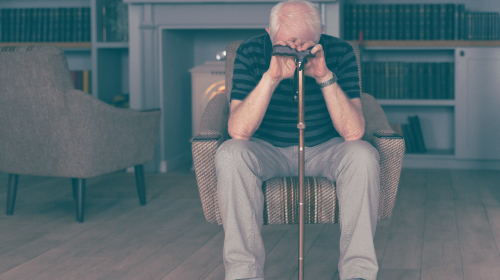Unveiling the Hidden Signs of Elderly Depression
Depression, a deeply nuanced and oft-overlooked mental health condition, can significantly impact older adults, presenting in ways that diverge from its manifestation in younger individuals. Among the senior population, particularly in the golden years, the symptoms can be subtle and easily misinterpreted. Recognizing these delicate indicators is crucial for families and caregivers, ensuring seniors receive the support they need for a more fulfilling and balanced life.
1. Lingering Melancholy and Withdrawal from Enjoyed Activities
The signs of depression elderly is an ongoing sense of melancholy or a retreat from once-beloved pastimes. Seniors who previously delighted in social activities, cherished hobbies, or family interactions may begin to exhibit a marked disinterest or reluctance to participate. Such withdrawal often transcends mere boredom or fatigue—it is a poignant indicator of underlying emotional turmoil that necessitates careful observation.
2. Unexplained Physical Complaints as Silent Cries for Help
For many elderly individuals, depression does not solely present as emotional distress; instead, it often manifests as vague physical complaints. Persistent aches, recurrent digestive discomforts, or chronic fatigue—absent a medical diagnosis—can signify emotional suffering. These physical expressions of psychological pain may reveal a struggle to verbalize deeper feelings of desolation.

3. Disruptions in Sleep Patterns Indicating Inner Distress
Alterations in sleep are frequently among the first indicators of depression in the elderly. Seniors may grapple with insomnia, find themselves waking intermittently during the night, or, on the contrary, sleep excessively, experiencing difficulties in staying alert throughout the day. Such disruptions in sleep are not merely inconvenient but a window into the elder’s emotional state, signaling an unease that requires gentle intervention.
4. Shifts in Appetite and Noticeable Weight Changes
Alterations in eating habits are a notable sign of depression in senior citizens. A sudden loss of interest in food can lead to unintended weight loss, while seeking solace in excessive eating may result in weight gain. These changes in appetite, whether a diminished desire for nourishment or a heightened craving, provide crucial insights into a senior’s psychological well-being.
5. Cognitive Impairment or Memory Lapses Beyond Normal Aging
While mild forgetfulness is often attributed to the natural aging process, it can also be an indicator of depression. Symptoms such as difficulty concentrating, indecisiveness, or memory lapses may be misinterpreted as cognitive decline. These signs of elderly depression may point to an emotional disorder rather than an inevitable aspect of aging, emphasizing the need for a careful and informed assessment.
6. Heightened Irritability or Agitation in Senior Men
In elderly depression signs may not present as visible sadness but instead as increased irritability, impatience, or restlessness. Unexpected mood swings, a quick temper, or a tendency to become upset over trivial matters can be indicative of deeper psychological struggles. Recognizing these less conventional symptoms of depression is key to providing the appropriate support.
7. A Burdened Sense of Guilt or Hopelessness
Expressions of guilt, worthlessness, or a sense of being a burden to others are significant signs of depression in elderly individuals. Seniors may ruminate on perceived past mistakes, dwell on regrets, or convey an overwhelming sense of futility. Such thoughts, if left unaddressed, can lead to a worsening of the condition, necessitating timely psychological intervention.
8. Decline in Personal Grooming and Attention to Appearance
Depression in senior men often erodes the motivation to maintain personal appearance or hygiene. They might neglect grooming, wear disheveled clothing, or show a diminished interest in self-care. This observable decline is a tangible manifestation of emotional suffering, requiring empathetic attention from loved ones and caregivers.
9. Increasing Social Isolation and Detachment
Social withdrawal is a telling sign of elderly depression. Seniors may gradually detach themselves from their social network, avoid gatherings they once cherished, or refrain from engaging in conversations with family and friends. This retreat from social interaction is often more than a preference for solitude; it’s a clear signal of emotional distress that should prompt concern and action.
10. Preoccupation with Mortality or Suicidal Ideation
In its more severe stages, depression in older adults can lead to a preoccupation with death or suicidal thoughts. This can manifest as a sudden focus on final arrangements, a desire to settle affairs, or conversations that hint at life’s futility. Such signs of depression in senior citizens should never be ignored, requiring immediate and compassionate mental health care.
Providing Compassionate and Effective Support
Recognizing the subtle signs of depression in seniors is the first and most essential step toward addressing their emotional needs. Depression in the elderly is not an inescapable facet of aging but a treatable condition that requires careful attention and support. Families and caregivers play a pivotal role in identifying these signs early, offering companionship, professional therapy, and, if necessary, medical intervention to restore a sense of joy and fulfillment.
The signs of depression in older adults are often nuanced, camouflaged beneath the ordinary aspects of aging. Yet, with a watchful eye, empathetic listening, and a readiness to respond, these signals can be identified and addressed. Depression in the elderly is a profound challenge, but with timely support and understanding, it is possible to rekindle hope and vitality, ensuring that the twilight years are imbued with dignity, contentment, and a renewed zest for life.
Facing the challenges of home care? Angel Care Inc. home care agency is here to provide expert, compassionate support every step of the way. Reach out to learn how we can guide your family with care and expertise.

In an age where technology increasingly permeates everyday life, selecting the tablets for seniors with dementia requires thoughtful consideration. In Brooklyn, where the senior community is vibrant and tech-savvy, the right tablet can open doors to digital literacy, enhance connectivity, and provide entertainment and convenience. This guide aims to illuminate the critical factors in choosing the best tablets for seniors 2024, ensuring they enjoy a seamless and enriching digital experience. 1. Easy to Use Tablets for Seniors When selecting a tablet, one of the paramount concerns for seniors is a user-friendly interface. A tablet with an intuitive design can significantly minimize any learning curve, making it easier for seniors to navigate without feeling overwhelmed. Look for tablets that feature simplified home screens, clear icons, and easily accessible settings. Larger screens with high contrast are particularly beneficial for those with visual impairments, ensuring every interaction is as seamless as possible. 2. Senior Simple Tablet: Prioritizing Display Quality and Size For seniors, display quality is not merely about aesthetics—it’s a matter of comfort and practicality. Senior citizen tablets with high-resolution displays provide crisp and clear visuals, enhancing the readability of text and the enjoyment of multimedia content. Screen size should be substantial enough to avoid unnecessary strain, with 10-inch screens often serving as an ideal balance between portability and visibility. 3. Considering Battery Longevity The tablet designed for seniors should have a robust battery life, reducing the need for frequent recharging. Tablets that can sustain usage for extended periods are particularly advantageous for seniors who may not be accustomed to charging devices regularly. Seek out models known for their power efficiency, as these will enable uninterrupted browsing, video calls, and reading sessions throughout the day. 4. Enhancing Audio Clarity Hearing can diminish with age, making audio clarity a crucial factor. A tablet equipped with high-quality speakers or the ability to connect seamlessly with hearing aids can significantly enhance the user experience. It’s also beneficial to opt for tablets that allow volume adjustment to higher levels without compromising sound quality, ensuring that seniors can enjoy content without strain. 5. Evaluating Connectivity: Internet Devices for Seniors Old person tablet should excel in connectivity. A tablet that supports a stable Wi-Fi connection and offers 4G or 5G capabilities ensures that seniors remain connected to loved ones and the broader digital world. Additionally, accessibility features such as voice assistants, enlarged fonts, and screen readers are invaluable for those with limited dexterity or visual challenges. Tablet for seniors no wifi offers a unique solution for those who prefer a simplified device experience without the complexity and potential security concerns of internet connectivity. 6. Simplified Setup and Maintenance A tablet’s initial setup should be as straightforward as possible. Choose tablets that offer guided tutorials or simplified onboarding processes to assist seniors in getting acquainted with their new device. Moreover, ongoing maintenance should not require complex technical skills. Opt for devices that provide automatic updates and have accessible customer support in case assistance is needed. 7. Weighing Budget: Best Inexpensive Tablet for Seniors While some seniors may wish to invest in top-tier models, others might prioritize cost-effectiveness. Fortunately, the market offers a spectrum of options that cater to different budgets without sacrificing essential features. It’s advisable to strike a balance between affordability and the device’s quality, ensuring that it meets all the user’s needs without being overly extravagant. 8. Exploring Compatibility with Health and Wellness Apps Health and wellness are increasingly supported by digital tools, and the right tablet can facilitate access to these resources. Many tablets are compatible with health-monitoring apps that track physical activity, heart rates, and medication schedules. Consider whether the tablet supports such applications, as they can serve as invaluable aids for seniors aiming to maintain a healthy lifestyle. 9. Understanding the Role of Protective Cases and Accessories To prolong the lifespan of a senior citizen tablet, protective cases are essential. Seniors can benefit from durable, ergonomic cases that provide a secure grip and safeguard the device from accidental falls. Additionally, consider accessories like stylus pens, which can assist those with limited dexterity, making navigation smoother and more precise. 10. What is the best tablet for seniors? While numerous models stand out, here are some noteworthy tablets that strike a harmonious balance between functionality and senior-friendly design: Apple iPad (10th Generation): Known for its simplicity, stellar display, and longevity, this tablet remains a perennial favorite for seniors. Its compatibility with health apps and robust app ecosystem makes it a versatile choice. Samsung Galaxy Tab A8: This mid-range tablet offers a user-friendly interface, long battery life, and affordability, making it an excellent option for seniors who seek quality without excessive cost. Amazon Fire HD 10: Perfect for budget-conscious individuals, this tablet offers a straightforward interface and features tailored for accessibility, like voice control and adjustable font sizes. Choosing the best tablet for seniors in NY in 2024 is about more than just hardware—it’s about ensuring that the technology fits seamlessly into their lifestyle, enhances communication, and provides a portal to new experiences. By focusing on user-friendly design, display quality, battery life, and connectivity, you can select a tablet that not only meets the practical needs of seniors but also enriches their daily lives. With the right device, the world becomes a more accessible and engaging place, empowering seniors to stay connected and informed. For those facing the challenges of home care, whether for yourself or a cherished family member, Angel Care Inc. home care agency Brooklyn and NY stands ready to offer expert and empathetic support at every stage. Contact us to discover how our dedicated team can guide your family with sensitivity and expertise through the distinctive complexities of home care.

As one advances in age, the pursuit of physical vitality and mental equilibrium becomes ever more crucial. For the elderly, yoga serves as a timeless practice that harmoniously balances body, mind, and spirit. With its gentle yet profound techniques, yoga for the elderly has seen a renaissance, becoming a cherished activity that nurtures health and enhances well-being. Yoga can be used as a form of physical therapy and is beneficial for regular exercise. This article explores the myriad benefits of yoga for seniors and showcases particular poses and routines tailored to their unique needs, fostering greater flexibility, strength, and serenity. The Multifaceted Benefits of Yoga for the Seniors Far from being merely a physical exercise, yoga is a holistic practice that can revitalize the aging body and soothe the mind. The benefits of yoga for the elderly are both extensive and transformative, making it an ideal practice for those seeking to age gracefully while maintaining their independence and vitality. Improved Flexibility exercises for elderly With advancing age, stiffness in the joints and muscles can inhibit movement. Senior yoga routines are specifically designed to gently stretch and elongate the muscles, enhancing flexibility and easing stiffness. These carefully curated exercises enable seniors to regain mobility and fluidity, promoting a greater range of motion. Strengthening Muscles and Enhancing Balance Strength and balance are critical for seniors, and yoga poses for elderly effectively target muscle groups that support stability. By focusing on gentle strengthening exercises, yoga helps to fortify the core, legs, and back, reducing the likelihood of falls and boosting confidence in movement. Each pose is an opportunity to build strength without the strain associated with more rigorous activities. Alleviating Stress and Cultivating Mental Clarity At the heart of yoga lies the practice of mindful breathing and introspection. These elements foster an inner tranquility that can alleviate anxiety, elevate mood, and clear the mind. For seniors, engaging in regular yoga can be a gateway to better mental health, encouraging mindfulness and reducing symptoms of depression, anxiety, and emotional turmoil. Joint Health and Pain Relief Without Medications Gentle yoga for seniors incorporates slow, deliberate movements that are particularly beneficial for those with joint discomfort. The gentle stretching inherent in yoga helps lubricate the joints, easing arthritis pain and improving overall joint health. For elderly individuals seeking non-pharmaceutical solutions to discomfort, yoga offers a natural and effective alternative. Building a Sense of Community and Belonging Engaging in yoga, especially in group settings, fosters a sense of connection and shared experience. Seniors often benefit from the camaraderie of attending classes with peers, combating loneliness and building a network of supportive relationships. This social aspect enriches the experience, providing both physical and emotional sustenance. Gentle Yoga Poses for Seniors to Cultivate Strength and Peace Yoga need not be complex or strenuous to be effective. Many poses can be adapted to suit the needs of older adults, providing both safety and comfort while delivering substantial benefits. Below are some essential yoga exercises that gently promote well-being. Mountain Pose (Tadasana) The Mountain Pose is a simple yet foundational stance that promotes balance and proper alignment. Seniors are encouraged to stand with feet shoulder-width apart, focusing on elongating the spine and breathing deeply. This pose strengthens posture and instills a sense of groundedness. Seated Forward Bend (Paschimottanasana) Ideal for those seeking a gentle stretch, this pose can be performed while seated on a chair. Leaning forward slowly, with a straight back, allows for a gentle stretch of the spine and hamstrings. It enhances flexibility and helps alleviate tension in the lower back. Cat-Cow Stretch (Marjaryasana-Bitilasana) This dynamic movement, transitioning from a rounded to an arched spine, can be performed either on hands and knees or seated. The Cat-Cow Stretch gently flexes the spine, promotes better circulation, and relieves stiffness. It’s a simple exercise that infuses the body with vitality and fluidity. Tree Pose (Vrksasana) A quintessential balance pose, the Tree Pose helps strengthen the legs and core. Seniors can place one foot lightly against the opposite ankle or calf, using a chair for support if necessary. This pose is particularly beneficial for improving focus, coordination, and equilibrium. Legs Up the Wall (Viparita Karani) This restorative posture involves reclining on the back with the legs elevated against a wall. It aids in reducing swelling, enhancing circulation, and calming the mind. This gentle inversion allows seniors to rest while reaping profound physical benefits, particularly at the end of a busy day. Child’s Pose (Balasana) A deeply restorative position, the Child’s Pose gently stretches the hips, knees, and spine. It can be performed with modifications, utilizing supportive props like a bolster. This pose provides a sense of surrender and tranquility, easing both physical and emotional tension. Creating a Safe and Sustainable Practice for Seniors When introducing yoga exercises, it is crucial to ensure that the practice is both safe and enjoyable. A mindful approach will foster a sustained interest in yoga, enhancing its benefits over time. Begin with Simple Movements and Progress Gradually Starting with accessible poses allows seniors to build confidence and skill. It’s essential to encourage them to move at their own pace, respecting the body’s boundaries and celebrating gradual progress rather than immediate perfection. Use Props to Provide Support and Stability Props like yoga blocks, bolsters, and chairs can be invaluable in making poses more accessible. These tools help to prevent strain, allowing seniors to focus on alignment and breath without overexertion. Incorporate Breathing and Meditation The breath is a central component of yoga, guiding each movement and promoting relaxation. Seniors should be encouraged to practice deep breathing exercises, known as Pranayama, which calm the nervous system and enhance mental clarity. Coupled with meditation, this practice fosters a state of mindfulness that extends beyond the yoga mat. Establish a Regular Routine for Consistent Benefits Consistency is paramount for seniors to experience the full spectrum of yoga’s advantages. Encourage a regular practice, even if it’s a brief daily session, to cultivate both physical and emotional well-being over time. Yoga is a gentle yet profoundly transformative practice that supports holistic health. Through carefully chosen exercises, seniors can improve flexibility, enhance balance, and nurture emotional tranquility. By integrating yoga into daily life, the elderly can rediscover a sense of vitality, joy, and inner peace, making their later years more vibrant and fulfilling. The benefits of yoga extend far beyond the physical, fostering a deeper connection with oneself and the world, enhancing the quality of life for seniors in remarkable and lasting ways. Encountering the challenges of home care? Angel Care Inc. is ready to offer skilled, compassionate assistance at every stage. Contact us to see how we can support your family with dedication and expertise.



